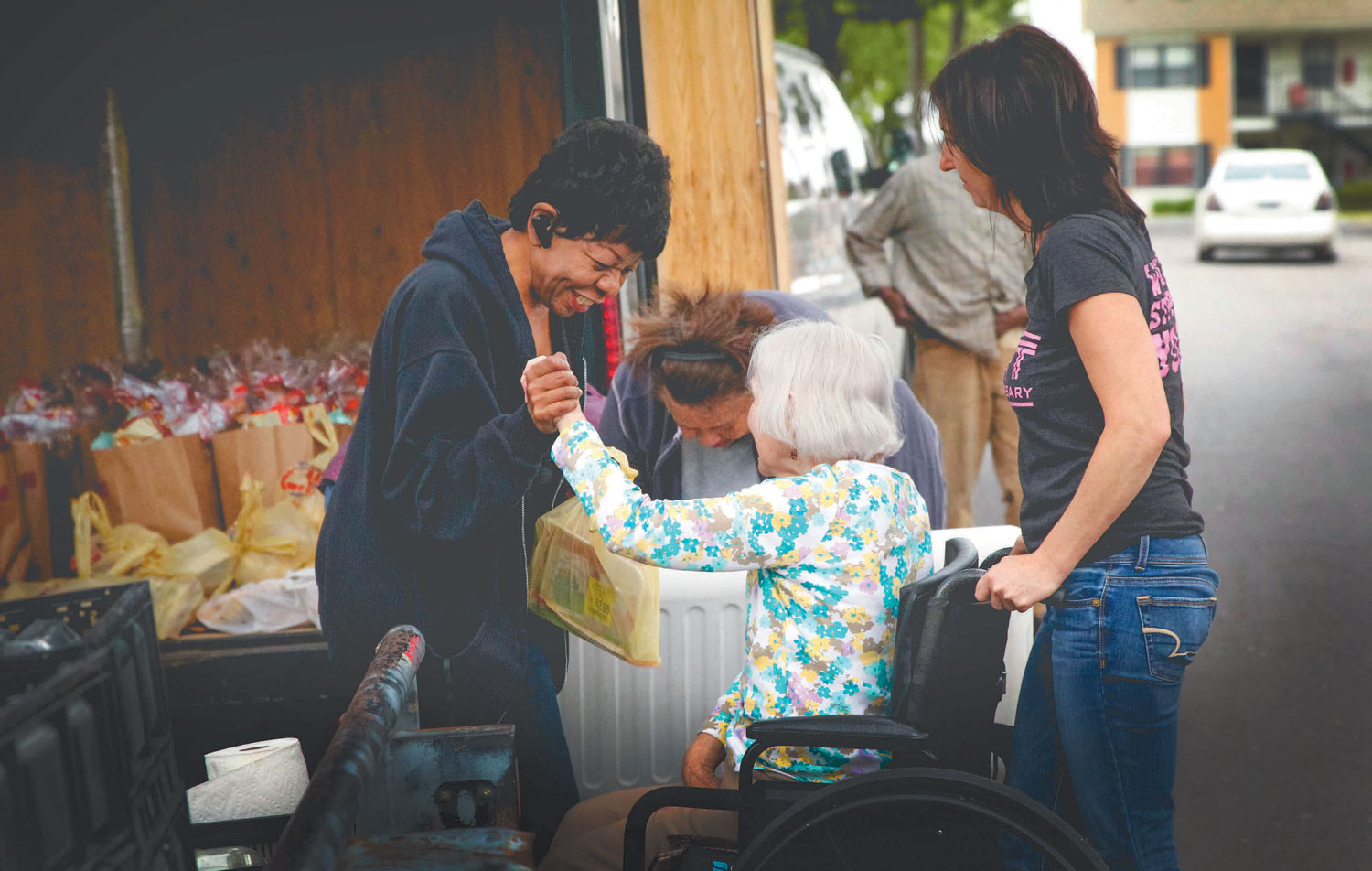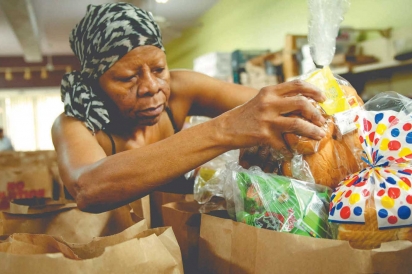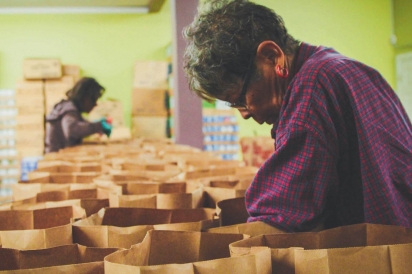Compassion in the River Valley
Charolette Tidwell grew up in Fort Smith as a middle child in a family of 10 children. Though her parents sometimes struggled to get by, she and her siblings never knew hunger.
Following a career in nursing and nutrition services, Tidwell (pictured above, on left) now dedicates her time and her own money to feeding more than 6,500 individuals each month in her hometown. She serves as director of Antioch Consolidated Association for Youth and Family, an organization that distributed more than 600,000 pounds of food in 2014. "I want to give away a couple of million," she says.
"I have proven to Fort Smith, Arkansas, that you don't need a ton of money to do that. You just need a will to do it–and do it."
She's done it for the past 15 years. In fact, her benevolent community work was featured in a National Geographic video that accompanied the magazine's coverage of hunger in America in its August 2014 issue.
Tidwell's passion and actions were born out of childhood experiences and the practices modeled by her community, church, and family. Her mother was involved in the outreach ministry of their church, King Solomon Baptist Church, which was located near the elementary school for a Catholic church. Her mother and older sisters cleaned the Catholic church to help pay for the children's tuition at the elementary school, which Tidwell attended from first though eighth grades.
Between the community outreach done by the nuns and her church, Tidwell grew up visiting senior citizens in nursing homes and prisoners in jail, giving out food and clothes, and lending help and hope. She says she thrived because she was surrounded by a community of adults who cared about her, believed in her, and gave her hope.
"When a mom or dad can't feed their kids, there is not hope and joy in that home," she says.
After completing the nursing program at Sparks Regional Medical Center, Tidwell had a career of more than 20 years there that included working in orthopedics, then the intensive care unit, and finally as director of medical nursing. She also operated some daycare centers for low-income families and worked in nutrition at Beverly Enterprises before finally retiring in 2000.
When she retired, she decided to go back to her roots–helping her community, in the tradition of her mother.
Helping those in need
Tidwell's mother regularly cared for others in the neighborhood and their church, and had wanted to be a nurse, but being the mother to 10 children left her with no time to go to school. Tidwell always sought to help ease the plight of other people in her community, so nursing appealed to her, too, as a career. "It's always that caring, compassionate personality, I think, that drives one to nursing," she says.
Her late husband, Lawrence, served more than 30 years as a Fort Smith police officer. Years ago, he and two fellow officers started the Lincoln Youth Service Center, an outreach for children and families on the north side of town, which had a high crime rate.
When Tidwell retired, she helped her church organization–Antioch Consolidated District Association–do outreach, with the seven small member churches working together. Though the churches couldn't sustain the effort, Tidwell took it over and incorporated it as Antioch Consolidated Association for Youth and Family.
Members of those churches volunteer to help accomplish the work, with about seven regular workers but up to 100 total volunteers. Tidwell uses part of her pension to purchase large quantities of food at the River Valley Regional Food Bank, where the money goes the farthest. She also finds some local stores that give her bargains on products or don't charge her taxes.
Still, the food bank doesn't have a very large selection of the fruits and vegetables she'd like to purchase because it needs to "build capacity."
"I'm interested in good nutrition," Tidwell says. "People function better, they become better citizens, your crime rate goes down–all of those things surrounding that improve."
Tidwell testified May 19 in Little Rock before the National Commission on Hunger, sharing her experiences with feeding the hungry in Fort Smith for the past 15 years.
A report by the National Foundation to End Senior Hunger found that the level of senior hunger in 2013 in Arkansas–26 percent–was higher than any other state. And, according to data collected in 2013 by Feeding America, Sebastian County had an overall food insecurity rate–just over 18 percent–higher than Benton, Carroll, Madison, or Washington counties.
Food insecurity refers to the U.S. Department of Agriculture's measure of lack of access, at times, to enough food for an active, healthy life for all household members and limited or uncertain availability of nutritionally adequate foods. Also in 2013, Feeding America found that Arkansas had a 19.7 percent rate of food insecurity, with the rate for children at 28.4 percent.
Tidwell says that, thankfully, she has never gone a day without food. "I've known poverty. I've known the No. 3 size metal tub that 10 kids bathed in," she says. "But I never knew hunger because we had a garden, and mother was industrious."
She sees families of four or more trying to live off of minimum wage jobs, with some parents working multiple jobs to make ends meet. Many impoverished people will buy a pack of lunchmeat, a bag of potato chips, and a soda because they don't have the means to keep groceries cold or to cook a meal at home. "Even though I was raised very poor, we had a stove, a refrigerator. . . all the essentials that were needed," she says.
Compassion's many facets
The organization that Tidwell directs involves the food pantry at their building on North 11th Street, mobile food delivery to area senior centers, and youth development.
From her years in nursing, she knew that senior citizens often had poor nutrition. Early in her career, she saw family and community members helping to care for the elderly in need, and elderly patients didn't take as many medications. During her later years in health care, she saw elderly patients coming in with gallon-sized plastic bags containing the medications that had been prescribed for their ailments.
She didn't understand how they could afford all of them. She also thinks that taking so many medications can be caustic to their bodies, and that eating better can help their health. "I believe that good nutrition in fact does decrease medical complications," she says.
As a child, Tidwell lived next door to her maternal grandparents. They shared a garden that ran the length of the property, and they would help her grandfather tend the crops.
Tidwell saw the small meals her grandmother would prepare: often a small cup of cooked beans and a hamburger patty. They grew what they could in their garden, and bought the rest at a neighborhood grocery store, where they had an account they paid on each month.
Even with Meals on Wheels and the federal Supplemental Nutrition Assistance Program, there are many people who don't quite fit the requirements, or whose need is greater than what those programs provide. "I knew there was a large gap that fell through the cracks with the elderly," she says.
With this food pantry, she tries to supplement what they already have with fruits, vegetables, and protein. She also doles out household basics such as toilet paper, paper towels, toothpaste, and deodorant, as she gets those supplies.
There are monthly deliveries to several senior centers, with twice-monthly stops to the largest one. Tidwell became more aggressive about seeking out those in need after an encounter at the grocery store. She was in line behind an elderly woman who bought several cans of pet food; the cashier confirmed that the woman was eating it herself.
Tidwell immediately started tracking down more housing complexes with elderly and disabled residents for food distribution.
"If they can cook, they do want to cook their food. And I think that is a very important area of independence," Tidwell says. "I believe as long as we can keep them independent, they do better–from a health perspective, from a psychosocial perspective, from a mental perspective. They just do better."
In her program, Tidwell also focuses on mentoring and developing youth. She gets them involved with the food pantry, and also works to connect them with educational programs, scholarships, and mentors.
"I want to get the minds of these children off of their conditions, which is impoverished. That's what this community did for me," she says. "It didn't allow me to languish in a state of mental poverty."
Tidwell refers to Abraham Maslow, the American psychologist, who created a hierarchy of needs. They start with physiological needs–such as food, water, and sleep–at the base, then elevate to safety, belongingness, esteem, and self-actualization.
"I can't talk to you about being an engineer when you go to bed hungry or you move every 30 days. Self-actualization is not even on their radar," she says. "We can't get to the pinnacle of actualization in Maslow's law until we meet these bottom needs."
Family by family
Starting this summer, Tidwell plans to host monthly giveaways at area parks on Saturdays, to reach the working poor. And, each Monday through Friday, volunteers give out food at the pantry on the city's historic north side. It's located in a two-story, red brick building at the corner of 11th and L streets that was paid for and donated by Robert Miller, a local businessman who is now president of the organization's board of directors.
On a recent Tuesday afternoon, individuals and families lined up outside the building and wrote their needs on pieces of paper. Inside, three female volunteers–the youngest in her 50s–helped Tidwell fill boxes based on the requests. As usual, Tidwell had cooked lunch for the volunteers–shrimp scampi with pasta, broccoli, and cauliflower.
The boxes, which sat on the floor near the door, held pasta, crackers, cereal, onions, potatoes, oranges, almond milk, protein shakes, a loaf of bread, plus some toilet paper. Volunteers loaded the dry goods first, and then added in the cold and frozen foods at the end, which that day included cheese slices, meats, bagged pasta meals, and Brussels sprouts.
Wearing a Bluetooth device on her ear, Tidwell regularly answered her phone while shuffling food items. Ending a call, she topped off a group of boxes with frozen pies. She opened the glass door and called out the first and last names written on a piece of paper in her hand. She called the next names, and then the next.
She doesn't turn anyone away.
National Geographic package on hunger
National Geographic video link
Editor's note: The referenced National Geographic video on hunger was produced by University of Arkansas Honors College alumna Shannon Sanders, a native of Flippin, Arkansas.






